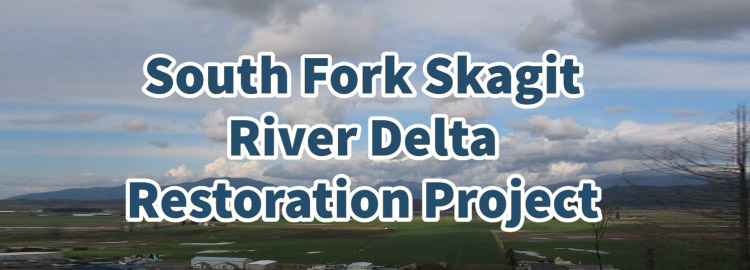Project Description
The south fork Skagit River delta restoration is focused on improving and expanding salmon habitat that was originally limited by the preexisting levee. The project began with a levee setback project that focused on replacing the original levee with one that allowed for increased habitat size and potential for native salmon in the location of a historic tidal channel.
Project Goals
The objectives of the project include: - increasing Chinook carrying capacity in a priority area;
- increasing the tidal exchange and floodplain connectivity to help reestablish the natural hydrologic exchange of the Skagit River, floodplain, and freshwater channels;
- increasing the wetland habitat of the site from zero to 5.3 acres during periods of Chinook use
- revegetate the site and remove knotweed and other invasive species
The project also provides an inlet at the upstream end that provides tidal flow and becomes a side channel in high-water events, which increases the channel length by 0.44 miles.
Fly over the project here:
Phase 1 Overview
In 2004, 2,550 feet of existing levee was set back and replaced by 1800 feet of new levee to improve salmon habitat along the Skagit river delta. The preexisting levee location was the site of previous failures. The relocation of the preexisting levee along the South Fork Skagit River restored 22 acres of tidal backwater wetland and channel habitats, which provided rearing and transitional habitat for several salmon species, which included chinook and Coho. A total of 37 acres of tidal wetland were restored, which provides habitat for approximately 14,600 young Chinook salmon, and 7,500 feet of tidal channels. Conservation easements were also included in the restoration, which allowed for protection of the habitat, as well as two bald eagle nest trees. Invasive plants were removed for 21 acres within the project.
Final Design
The final design of the project was drafted by Anchor QEA in July of 2019, which transitioned the preliminary design to the final design. The final design built on the preliminary design, which was chosen as the preferred alternative design as it allowed for the highest number of expected smolts (expected at 54,000), the lowest long-term maintenance issues, and highest sustainability of the drafted alternate designs. The final design’s key goal focused on sustainability, but allowed for prioritizing habitat as well. During the final design drafting, Skagit County, Anchor QEA, and Dike District 3 were able to draft a final design that allowed for no removal of rocks along the river as per Dike District 3’s requirements by shifting the proposed inlet southward to a location with deeper-set rocks and a natural depression along the river. This allowed the final design to meet the District’s requirements as well as reduce the amount of material removed from the site.
The final design also shifted the channels outlined in the preliminary design west, towards the river, in order to reduce the levels of piping experienced at periods of high water within the project area. Currently, the farm fields east of Dike Road and the project area both experience piping during high water events, which is mitigated for in the final design.
Construction FundingAll funding has been secured for construction of the project. $2,065,700 has been secured from the Salmon Recovery Funding Board, with $200,000 funded by National Fish and Wildlife, and $2,400 from the Trout and Salmon Foundation. Skagit Fisheries Enhancement Group was awarded $39,000 from the Department of Ecology to assist the County with replanting.
Construction
Skagit County hired Tiger Construction to complete installation of the project. In total they removed over 100,000 cubic yards to material from the site. This included clearing over 9 acres and placing many of the trees into the ponds as habitat features moving forward. Construction took from July through October in 2022. Skagit Fisheries Enhancement Group will be working on replanting in late 2022 and early 2023. We’re working with the Skagit River System Cooperative to complete monitoring of the site.
Partners
Staff Contact:
Emily Derenne - Habitat Restoration Specialist
360-416-1449
emilyjd@co.skagit.wa.us | 
